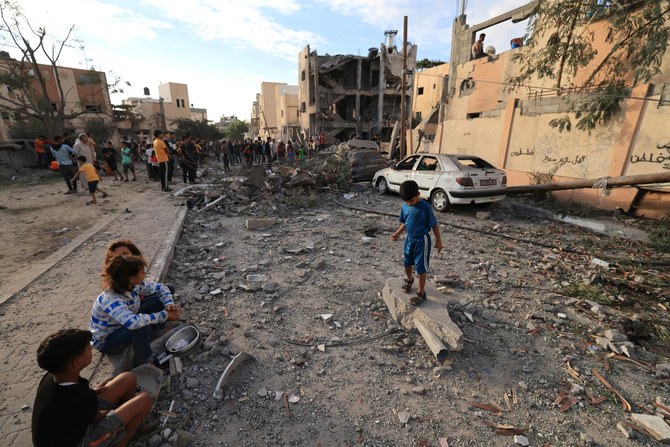
- ARAB NEWS
- 01 Jul 2025

Arab children are facing an unprecedented assault on their young lives. In the Middle East and North Africa, UNICEF estimates that more than 61 million children reside in countries impacted by conflicts, meaning a shocking one in every three Arab children experiences the ravages of violence. And Defense for Children International — Palestine, an independent, locally based Palestinian child rights organization, estimates that 1,200 Palestinian children have lost their lives during this month’s eruption in the Israeli war on Gaza.
Dire humanitarian settings can have multifold detrimental effects on children. At their core, deep psychological traumas can damage the lives of children, having long-lasting harmful effects on their emotional and mental well-being. Young victims commonly experience symptoms such as anxiety, depression, reduced self-worth, sleep disturbances, post-traumatic stress disorder, social isolation, separation anxiety and profound feelings of grief for the loss of family and friends.
Conflicts often compel children and their families to abandon their hometowns, resulting in forced displacement and the erosion of community ties, leaving them without a support system and having to face an uncertain and precarious future on their own. Forced displacement also leads to a disruption in the education pathways of school students, which reduces their chances of gaining the skills essential to securing employment in the future. At the same time, some children may be forced to engage in child labor as a means of survival, possibly exposing them to exploitation.
Children living in conflict zones can also suffer from debilitating physical injuries or long-term disabilities, drastically reducing their quality of life. The disruption of food supplies in conflict zones can lead to famine and malnutrition, which take a heavy toll on children’s health in the form of stunted physical and cognitive development and developmental delays. At its worst, child mortality rates are higher in conflict zones due to ongoing violence, malnutrition and a lack of access to health services to treat illnesses or injuries.
The disruption of food supplies in conflict zones can lead to famine and malnutrition, which take a heavy toll
Sara Al-Mulla
Protecting and supporting Arab children affected by conflicts is a crucial humanitarian and policy challenge that must be urgently tackled. Multifaceted policy solutions, when implemented comprehensively and collaboratively, can significantly contribute to protecting children in conflict zones and ensuring their rights and well-being are safeguarded. Priorities must bear in mind a number of essential areas that address the needs for shelter, psychosocial support, health and nutrition, education, safety and security, family reunification and child protection mechanisms.
Child monitoring systems must be established to track the status of children in all these areas. For a clearer picture, the registration of children at birth must be adhered to, in addition to collecting multifaceted, comprehensive data on children. Humanitarian crises usually affect the livelihoods of families, which is why assistance programs must be set up to provide support for families with children in order to reduce economic pressures. These can be in the form of housing or shelter, food vouchers, clothing, healthcare or childcare subsidies so parents are able to work. Child-friendly spaces must be built so that children can safely play and interact with local communities. Such spaces could also serve as bases for providing a range of vital family-related services and resources, such as parenting classes, counseling, child development support, youth mentoring programs and legal aid clinics.
Access to competent, timely healthcare services will remain paramount to the well-being of children living in conflict zones throughout their early years and through adolescence. The spectrum of services must include regular checkups to monitor their development milestones, the administration of compulsory vaccinations and treatment for various pediatric illnesses. Humanitarian settings are fraught with high risks for physical injury or death, necessitating the provision of prompt emergency services for the treatment of injuries in order to minimize the risk of permanent disabilities or child mortality.
Access to competent, timely healthcare services will remain paramount to the well-being of children living in conflict zones
Sara Al-Mulla
Education must be on the agenda of any humanitarian strategy in order to safeguard the well-being of children and improve their prospects for the future. Primarily, safe and temporary learning environments should be established in various suitable locations so children can continue their education. Classes could be scheduled at flexible times and access to online classrooms and e-learning resources could be a transformational solution, considering the number of volatile situations in the region. Support will be needed to distribute books and school supplies for children, in addition to setting up mobile libraries to travel around and distribute books.
There is no doubt that conflicts can have a resounding impact on children’s well-being. As such, it is of paramount importance to garner the specialized assistance of social workers, teachers and psychologists to equip children with the resilience to face various emotional and mental challenges. Integrating trauma education, stress-reduction techniques and coping strategies for anxiety or fear can help alleviate some of the effects of conflicts and enhance resilience. Moreover, children should be informed about what steps to take in the case of further emergencies in order to protect themselves.
Amid the chaos of warfare is the potential for the separation of children from their families, making them particularly susceptible to experiencing violence, abuse, exploitation and neglect. To adeptly address and respond to this challenge, it is vital to put in place robust interventions that tackle the issue of separation itself, offer temporary or alternative care solutions and ultimately lead to the reunification of separated children with their families through family tracing programs. In light of these significant challenges, it is imperative to maintain communication channels so children can seek assistance from specialized and dedicated child protection teams. Vitally, deploying grassroots community-centered child protection networks will help detect and address child protection concerns when they arise.
Considering the formidable challenges that children have to face, it is critical that global, regional and local stakeholders work together to ensure their safety and well-being.